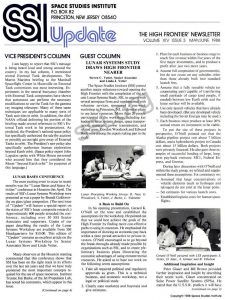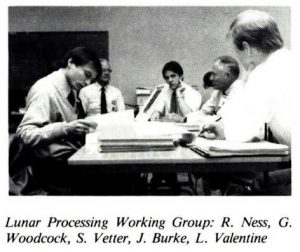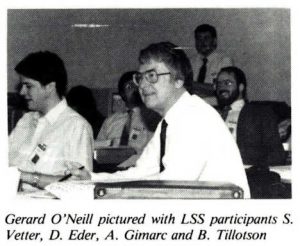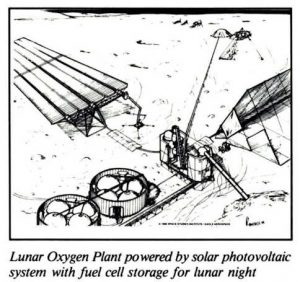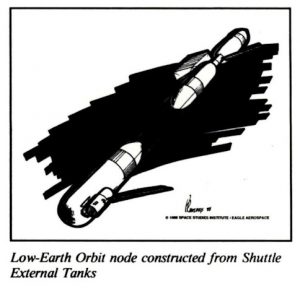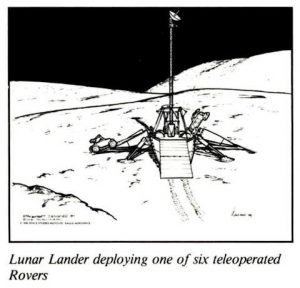SPACE STUDIES INSTITUTE
P.O. BOX 82
PRINCETON, NEW JERSEY 08540
[[librarian note: This address is here, as it was in the original printed newsletter, for historical reasons. It is no longer the physical address of SSI. For contributions, please see this page]]
SSI UPDATE
THE HIGH FRONTIER® NEWSLETTER
VOLUME XIV ISSUE 3 MAY/JUNE 1988
VICE PRESIDENT’S COLUMN
I am happy to report that SSI’s message is being heard loud and strong around the country. In my last column, I mentioned several External Tank developments. The Martin Marietta briefing to the Marshall Spaceflight Center in Huntsville on External Tank conversions was most interesting. Experiments in the neutral buoyancy chamber with External Tank components have shown that astronauts can perform the necessary modifications to use the Tank for the gamma ray imaging telescope. Many of these same techniques are applicable to many sorts of Tank activities in orbit. In addition, the chief NASA official delivering his portion of the briefing made several references to SSI’s External Tank work in his presentations. As predicted, the President’s national space policy has specifically authorized the sale (by auction) or possibly an outright give-away of External Tanks in orbit. The President’s new policy also specifically authorizes human exploration beyond Earth orbit. (Space policy expert John Logsdon spoke with White House personnel who assured him that they considered the Moon “beyond Earth orbit” for purposes of this language.)
LUNAR BASES CONFERENCE
The most exciting event to occur in recent months was the “Lunar Bases and Space Activities” conference in Houston this April. The results of SSI’s Lunar Systems Workshop were presented as was a paper by Brandt Goldsworthy on glass/glass composites. (The next issue of “Update” will feature a special report on the status of SSI’s lunar composite research.) Approximately 600 people attended the conference, including over 30 SSI Senior Associates and supporters. Copies of our paper describing the results of the Lunar Systems Workshop are available from SSI Headquarterrs for $10.00. This edition of “Update” contains an excellent article on the Lunar Systems Workshop by Senior Associates Steve and Linda Vetter.
Many observers at the Houston meeting commented that this conference shows that SSI has been on the right track in its efforts over the last ten years and that we have truly pioneered the most important concepts required for the use of space resources. Institute Trustee Jim Burke, of the Jet Propulsion Lab, has noted his comments, which appear in this issue.
Most importantly, the space community is beginning to realize that space operations must yield real economic returns in order to become self-sufficient and robust. SSI’s approach of scaling initial operations to the smallest viable “seed” and then bootstrapping or allowing the system to grow from its initial output products is being recognized as a critically important way to initiate the breakout into space. Many thanks to all of you for your support the Institute’s work. In particular, thanks for your strong support for the Lunar Systems Workshop.
Gregg Maryniak
GUEST COLUMN
LUNAR SYSTEMS STUDY DRAWS HIGH FRONTIER NEARER
Steven C. Vetter, Senior Associate and Linda J. Vetter
The Space Studies Institute (SSI) passed another major milestone toward opening the High Frontier with the completion of the recent Lunar Systems Study. SSI, in concert with several aerospace firms and supplemented with volunteer services, sponsored a one week workshop in Princeton, NJ, to develop plans to use lunar resources. More than 20 people participated in the workshop, including key leaders in lunar systems design, space transportation, materials, power transmission, and related areas. Gordon Woodcock and Edward Bock were among the experts taking part in the study.
A Basis to Build On
In his opening presentation, Gerard K. O’Neill set the tone and established the assumptions for the workshop. He pointed out that we could best achieve the goals of the High Frontier by finding more cost-effective paths to using its resources. He emphasized the importance of showing an economic payback within a time period attractive to private investors. O’Neill encouraged us to go beyond the break-throughs already made possible by organizations such as SSI, and to create preliminary business plans illustrating the economic advantages of using extraterrestrial resources. He asked us to base our work on the following seven assumptions:
1. Take all required political and regulatory approvals as given. This is a technical business, and economic workshop, not a legal or political study.
2. Clearly state market(s) and buyers(s) and give estimates.
3. Plan for each business or business stage to reach first revenue within five years of the first major investments, and to produce a profit after just two more years.
4. Assume full cooperation of govemment(s), but do not count on any subsidies other than those already built into standard launch fees.
5. Assume that a fully reusable vehicle (or cooperating pair) capable of transferring small payloads of cargo (and people, if needed) between low Earth orbit and the lunar surface will be available.
6. Use only launch vehicles that have already been developed. (But any developed vehicle including the Soviet Energia may be used.)
7. Each business must produce at least 20% annual return on investment to be viable.
To put the size of these projects in perspective, O’Neill pointed out that the Alaska pipeline project cost about 7 billion dollars, and a hydroelectric project in Canada cost about 15 billion dollars. Both projects were privately financed. He also gave three examples of successful funding of large, longterm payback ventures: MCI, Federal Express, and Geostar.
During later discussions with O’Neill and within the study group, we refined and supplemented these assumptions. For consistency we:
– Assumed that large concentrations of volatile elements (such as hydrogen and nitrogen) do not exist at the lunar poles.
– Set estimates for various launch costs.
– Established logistics costs for human spaceflights.
Additional Inspiration and Insight
Peter Glaser and Bill Brown provided further inspiration and insight by describing their recent work. Glaser concentrated on Solar Power Satellite Systems (SPSs). He stated that the U.S.S.R. predicts it will have $180 billion in SPS revenues by 2010. Brown reported about a microwave powered airplane recently demonstrated in Canada. He showed a videotape of some actual flights, and passed around a sample of the rectennas used on the plane to receive the microwaves. Brown estimated that an SPS system using this technology could realize 58 – 72% DC – to – DC efficiencies.
[[librarian note: the next issue of UPDATE printed a correction to the above Glaser statement. The correct sentence should have been: “He stated that the U.S.S.R. predicts it will spend $200 billion on space power by 2010.”]]
Getting Down to Work
The study group’s first task was to identify space-based products and services that could be offered. Next we formed smaller study groups, each concentrating on one major market. By mid-week, each group generated a draft business plan. We met again as a whole to discuss the draft plans, then split into slightly different groups. Some of these groups concentrated on further defining the most promising of the business plans, while others concentrated on clarifying key aspects of a High Frontier industry. At the end of the week, the entire group reassembled to assess the results, and agreed to compile a final report for SSI.
Products and Services
Group brainstorming sessions resulted in abundant lists of ideas of lunar-related products and services. One way we considered categorizing products was by the level of processing needed to generate them. For example, raw materials could be used for shielding, reaction mass, and even souvenirs. Glass, iron ore, oxygen, lunar concrete (“lunarcrete”), and fiberglass could be made available with simple processing. while more complex processing would be required for many metals. Asteroids, which could provide the very important volatile elements, were considered as sources of materials, but only in the long term because of the great distances and travel times involved.
The one product with by far the largest long-term potential continues to be electrical power from Solar Power Satellite Systems (SPSs). Unfortunately, because of the physics of microwave optics and the need to use extraterrestrial materials, an Earth-surface SPS to generate power must be extremely large. Estimates range from one to ten gigawatts for a minimum system that is economically viable. Such a system would require an initial investment on order of $10 billion, even if it leveraged other key breakthroughs such as lunar-based mass drivers. Multiphased bootstrapping could significantly decrease this initial investment number.
Another technique to build an economically viable infrastructure leading to SPSs is the “house of cards” approach. Several companies, each selling products to one another, could show economic viability, while creating a complete space-based manufacturing capability. For example, a lunar oxygen plant could sell its product to a space transportation company. This company in turn could sell some of its services to the lunar oxygen plant to ship supplies, people and products around in space.
An ultimate external source of revenue would be necessary to make the entire system work. In the long run, this would mainly come from SPS systems. In the short run, revenue from almost any source would do.
Major Markets
Early on, the study group identified the following five major markets: Low Earth Orbit (LEO) Services, Orbital Transportation, Quick-return Lunar Services, Lunar Mining and Manufacturing, and Space Power Systems.
We proceeded to treat each market as a “company,” and subgroups worked to come up with a business plan for each company during the course of the next few days. The full results of this effort will be published by SSI in the near future. Meanwhile, here are some of the highlights.
Some of the plans could be implemented with initial investments in the range of $100 million, which is an improvement of two orders of magnitude over previous estimates – an important step toward establishing economic viability of space-based companies. Each subgroup identified a potential growth path from the initial investment to an everincreasing business. Each of these “phases” would be economically viable based on the assumptions laid down from the start, with each new phase building on the structures and profits from the earlier phases. Here are some of the proposals, listed roughly in phase order:
* LEO Services
* Fuel depot
* Turn-key space platforms
* Variable-gravity laboratory, habitat, and hotel
* Orbital Transportation
* Plane/rocket pairing
* Tethers
* Ion drive (based on lunar liquid oxygen)
* Quick-return Lunar Services
* Robotic lunar rovers with cameras for scientific experiments and entertainment (racing, etc.)
* Personal items and vendor products brought to the moon
* Lunar Mining and Manufacturing
* Prospecting and assaying
* “Pet rocks,” jewelry, etc., from lunar soil
* Liquid oxygen for fuel and life-support
* Steel
* Space Power Systems
* Small market, unless microgravity manufacturing takes hold
* Very high-priced (“‘$10/Kwh) -Earth power
* Huge market
* Low-priced (~$0.045/Kwh)
* Transmitter/receiver size limits
* Extraterrestrial materials needed to be cost effective
To reiterate, the activities of these companies would result in the creation of an infrastructure sufficient to support the construction of very large space structures, such as SPSs and habitats.
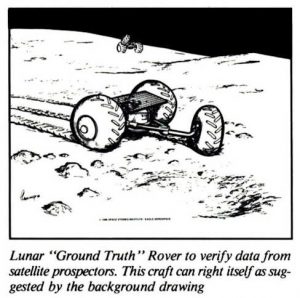
Infrastructure for the High Frontier
Next the Lunar Systems Study group set out to define the required infrastructure in more detail. This was done in several steps. First the group formed a matrix of all the tools needed to open the High Frontier versus where these tools would be needed (Table 1).
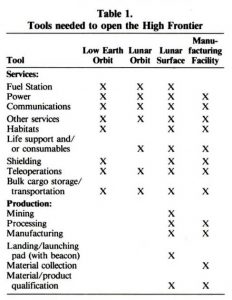
As mentioned earlier, in order to be successful, this infrastructure would have to be self-sustaining. This, combined with the expected final products (such as power supplied to Earth), drove the study group to focus on five main product categories: shielding, power generators, radiators, propellants, and pressure tanks. The group concentrated on designing a system that could produce these products in large quantities.
The infrastructure to produce these products was divided into the four “nodes” first identified by Gerard K. O’Neill: Low Earth Orbit, Lunar Orbit, Lunar Surface, and Manufacturing Facility. The study group broke into subgroups to further define each of these nodes. Each subgroup considered the tools needed, the contributions the given node would have to make to produce the five main product groups, and the various financial considerations studied earlier.
Low Earth Orbit, Lunar Orbit and Lunar Surface Nodes
The low Earth orbit node can be selfsufficient, returning a profit in just three or four years. This is partly because of its close proximity to the Earth, but primarily because of the relatively quick and inexpensive access to External Tanks. The lunar orbit (low lunar orbit, LI, and L2) node includes a fuel depot, docking capability, mass-catcher, and extensive use of teleoperations. Power supply is a primary consideration of the lunar surface node. Because of the long lunar night (~14 days), solar power has severe limitations on the Moon. We considered four options in detail: nuclear power, a solar-powered base at one of the poles, solar power transmission from the poles or space-based SPS and power storage during the night.
Manufacturing Facility Node
The manufacturing facility node is the only node without a specific location. We agreed that processing and manufacturing cost of construction labor. In all likelihood, the processing and manufacturing facilities will be partly on the lunar surface and partly in space.
Bootstrapping (using a small plant to build larger objects) and self-replication (using an initial plant to build one or more copies of itself) will play vital roles in cutting the initial investment required to reach the High Frontier. In terms of the products involved in bootstrapping, iron and steel emerge as important basic materials for production (second in importance only to oxygen). By definition, the initial manufacturing capability must come from Earth. Because of the importance of bootstrapping as much of the lunar base as possible, this initial plant is likely to be placed on the Moon. To maximize self-replication and to emphasize iron and steel production, the initial plant probably will be an iron or steel mill with a job shop (primarily a lathe). One study participant suggested that someone sponsor a contest in schools to design a lathe that can build as much of a copy of itself as possible. Space-based manufacturing facilities would have inherent power supply advantages, because of their exposure to sunlight nearly 100% of the time. This avoids many of the problems of supplying power to the lunar surface, such as having to store large amounts of power for long times.
The Lunar Systems Study generated an abundance of interesting ideas and useful plans. One thing that helped bring these ideas and plans to life was the artwork done by Pat Rawlings of Eagle Engineering during the study. As people came up with designs and ideas, Pat quickly rendered them on paper. In the process, Pat was able to share some of the extensive knowledge of spacecraft design he has gained over the years in doing such artwork.
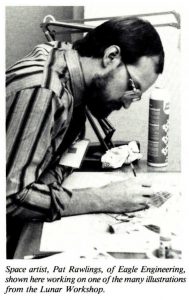
The accomplishments of this study will be enhanced in the coming weeks as the study participants turn their thoughts into detailed designs and papers. We have made tremendous progress in technical and financial planning, but much work remains to be done. For example, market research is sorely needed. In addition, while we have identified ways to bring the level of initial funding needed to break out into space down another two orders of magnitude, to about $100 million, all of the business plans would benefit from decreasing launch costs even further. Teleoperations show great potential for use throughout all of our scenarios, and stand to gain much from additional technical research. Finally, there are still significant political barriers to be overcome. However, showing the great potential of the High Frontier through studies such as this one arms us with a strong case for overcoming these barriers and helps us identify where we must concentrate our efforts. We can achieve our goals, all within a context of seven year or shorter paybacks and using essentially today’s technology. SSI’s efforts supporting this conference have brought the High Frontier much closer to reality.
PRESIDENT’S COLUMN
The following article is the Foreward to “The Overview Effect: Space Exploration and Human Evolution” by Senior Associate Frank White. The publisher is Houghton Mifflin Company.
Foreward
One of the first people to appreciate that humankind will not remain forever bound to the planet of its birth was Konstantin Tsiolkowski. Early in this century he set forth clearly the basic facts of nature which make possible, even inevitable, a civilization in space. There solar energy is a full-time energy resource, as it can never be on a planet. Gravity, of any amount desired, can be provided in space by rotating at the correct speed a habitat which can hold an earthlike atmosphere.
From that realization it is but a short step to the knowledge that every star, even the nearest, is a sure target for human migration. Every star is, like our Sun, a source of energy. And every star is circled by material which can be formed into space habitats. The atmosphere and the gravity for those habitats can be freely chosen by our descendants who will one day build them. Those facts liberate us from a longstanding mental hangup: that the nearest target for stellar migration must be a Sol-type star orbited by a planet with gravity and atmosphere much like those of Earth. In that context, Frank White concentrates on the right questions: what changes in viewpoint occur when humans see the Earth as a unified whole, and what changes will occur in the aspirations, the values and the historical course of the human race when it sets its pioneering course outward, to the solar system and ultimately the stars.
Frank White is one of a growing number of people who are not content with speculation on the human breakout from the bonds of planet Earth. Those people devote much of their creativity and their hard work to making that breakout to a new ecological range a reality in their own time, rather than leaving it to an uncertain future. His work, contributed freely to the National Commission on Space, came at a critical point in the deliberations of that Commission, and became the organizing theme about which its report was written. That speaks much for the universality of White’s theme. The Commissioners were a group of fifteen people of diverse backgrounds, all with expertise and experience in some aspect of space development, but otherwise of very different philosophies and degrees of conservatism. They agreed upon and embraced a set of goals which would have seemed unreasonably futuristic to most experts on space just ten years earlier: first and most central, that humanity was destined to break the shackles of Earth’s gravity and move outward to inhabit the solar system. To that central goal others, humanitarian and peaceful, were joined naturally by the historical analogs of our Constitution and Bill of Rights. Overall, they are a set of goals in which every human being can take pride. They state the best of human aspirations: that humankind should be free, that individual choice should be respected, and that material well-being should go hand in hand with that respect. They state those aspirations within a context where they can in fact be realized: a context of virtually unlimited resources of energy and materials and, ultimately, of land area.
It is the hope of those who work toward the human breakout from planet Earth that the establishment of permanent, self-sustaining colonies of humans off-Earth will have three vital consequences: first, that it will make human life forever unkillable, removing it from the endangered species list, where it now stands on a fragile Earth over-armed with nuclear weapons. Second, that the opening of virtually unlimited new land area in space will reduce territorial pressures and therefore diminish warfare on Earth itself. Third, that the small scale of colonies in space, the largest some tens of thousands of people, will lead to local governments which are simple in form, responsive to the desires of their people, and as reachable and intimate as were the New England town meetings of America’s heritage.
Beyond those immediate needs of survival and freedom we look to our purpose as a species. We are far too diverse, far too individual and contentious, far too divided by conflicting religious and ideological dogmas, ever to be likely to agree on a single long-term goal for humanity. And we are far too impatient, too short in our attention spans, to hold to such a goal for time of many generations. But fortunately the realities of time and space, in the era of humanity freed of Earth’s bonds, will lead inevitably to results that will transcend any program we might devise.
In a relatively short time they will bring a higher degree of independence to human communities than is now possible on Earth. In a longer time the effects of genetic drift will show, as human groups separated by great distances evolve into noticeably different forms of humanity. In a much longer time – but a time still short compared to the interval over which homo sapiens evolved – there will spread through our galaxy a variety of civilizations, all traceable, though some may forget their origins, to one beautiful and precious planet, circling a minor star near the galaxy’s edge.
INTEREST IN LUNAR BASES RISING; SSI CONCEPTS ADVANCING
Comments by SSI Trustee Jim Burke of JPL on the Lunar Systems Workshop
As the idea of a permanent human presence off Earth becomes more broadly accepted, the necessity of using off-Earth resources becomes more obvious. Thus, with the passage of time, the concepts that led G.K. O’Neill to found SSI are finding their way into a wider community, validating SSI’s purposes and increasing the chance that our visions may become reality.
The latest evidence of this proliferation was a large symposium, the second in an intended series of the subject of Lunar Bases and Space Activities of the 21st Century. The first such meeting, held in 1984, resulted in the book of that title published by the Lunar and Planetary Science Institute in Houston. The 1988 symposium, convened in Houston by Wendell Mendell and colleagues at LPI and the Johnson Space Center, was sponsored by those institutions and by SSI, together with the American Institute of Aeronautics and Astronautics, the American Geophysical Union, the American Society of Civil Engineers, the American Nuclear Society, and the National Space Center.
The recent meeting drew an attendance of more than 500. Some two hundred papers were presented, many in parallel sessions. Session topics included Earth-orbital way stations, human factors and life support, lunar base architectures, Earth-Moon-Earth transport, scientific uses of lunar bases, resource extraction and uses, lunar agriculture, technology, and legal and policy questions. The meeting provided material for a symposium volume which, when published, will set in place new foundations of knowledge and should give a strong stimulus to further work. Despite the absence of any acknowledged lunar base initiative by either the U.S. or the Soviet government, it is clear that well-prepared groups in both countries have recognized the potential of human residence on the Moon and are moving toward making it a reality. Supporters of SSI should be proud and pleased with the role that our Institute has played in advancing humanity toward the Moon.
©space studies institute

